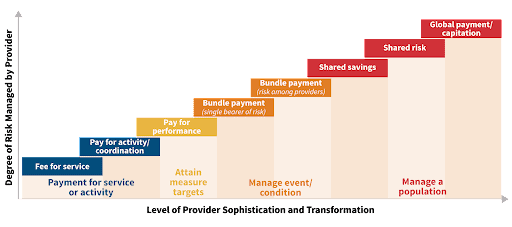Journey Towards Value-Based Payments Part 1: Challenges to a Better Healthcare System
Understanding the challenges of future value-based payment implementation is crucial for forging a successful path forward
THE VBP Blog

May 4, 2023 – Since the Affordable Care Act (ACA) was passed in 2010, the Centers for Medicare and Medicaid Services (CMS) has looked to move the U.S. health care system from one that incentivizes volume to one that rewards value. A key part of this strategy has been shifting from fee-for-service (FFS) payment to value-based payment models that improve quality and reduce costs.
While the shift to VPB is happening, things have been moving slowly, but the potential of value-based payments cannot be overlooked. Value-based payment models have the potential to revolutionize the healthcare industry, improving patient outcomes while reducing costs. In this blog post, we’ll delve into VBP models and outline key strategies for successful implementation in the years to come.
What Are Value-Based Payments?
Value-based payments are transforming the healthcare industry. In a traditional fee-for-service (FFS) model, healthcare providers are paid based on the number of services rendered. Value-based payments differ from this by paying providers based on the health outcomes they achieve. This means under a VBP model, providers are rewarded for delivering high-quality, cost-effective healthcare that improves overall patient outcomes. Value-based payment models are unique because they align incentives with better health outcomes.
These models have the potential to transform the healthcare industry by improving quality of care and reducing overall healthcare spending. We believe in it so much so that we have written exclusively on value-based payments in our blog and have an entire website devoted to helping those in the industry understand VBP. However, for value-based payment models to make a true impact, they need to be far-reaching. But how do we expand value-based payment models?
The Challenges of Widespread Value-Based Payment Implementation
The journey towards widespread value-based payment implementation does not come without challenges. To navigate the complex healthcare landscape and foster the transformation, we must first look at the barriers that stand in the way. Let’s explore some key areas that require attention as we look to shift healthcare to value-based payments.
1) Improving Data Sharing and Collaboration
Seamless data exchange is essential for VBP programs to find success. That is because healthcare providers need access to comprehensive patient data so they can make informed decisions and deliver personalized care that their patients need and deserve. To drive value-based payment implementation, the technology infrastructure must be in place to promotes secure and real-time data exchange. This enables providers to ensure they’re not running unnecessary duplicate tests that are both costly and drive down patient satisfaction.
The shift towards value-based payments also requires collaboration between providers, payers, consumers, and community service providers. With a focus on whole-person care, providers need to work together to address all the medical and non-medical needs of their patients to achieve the best health outcomes possible. While data sharing makes this possible, stakeholders also need to be willing to adopt a collaborative mindset to provide whole-person care and address needs that go beyond the typical services provided under an FFS model.
2) Shifting Down VBP Continuum to Increase Provider Risk
Another key challenge that we face when implementing value-based payments is providers’ willingness to accept more risk. Shifting the entire healthcare system cannot happen overnight, which required the ability to ease providers into more advanced VBP models. Due to this, a spectrum of VBP models exists, ranging from ones that mirror FFS to advanced models that have two-sided risk. This is called the value-based payment continuum and the spectrum can be seen below.

Source: Optum Inc.
The difficulty in advancing value-based payment models in the future is getting providers to buy-in and accept more risk when managing a population. Many are willing to share in any savings by implementing VBP models, but in order for true transformation to occur, we must move down the VBP continuum to shared risk and capitation arrangements.
3) Addressing Regulatory Barriers
Regulatory barriers can also slow the adoption of value-based payments by creating uncertainty and confusion for providers. To address this, all stakeholders should be involved in the process of developing and implementing VBP programs, including providers, payers, policymakers, and patients. Developing new payment models requires open communication, trust, and collaboration. Throughout the process, policymakers must also work to simplify and streamline regulations as much as possible. This includes reducing administrative burdens, providing clear guidance, and offering incentives to encourage providers to embrace these new models.
4) Engaging and Empowering Patients
While the emphasis of VBP programs is on incentivizing providers to provide better care, patient engagement is a critical component of that. When patients take an active role in their healthcare, it can lead to better outcomes and increased satisfaction. That means giving consumers the tools to communicate effectively and creating an environment where they feel safe to discuss non-medical issues that may be impacting their health, including housing, transportation, and nutrition. However, getting consumer buy in is not as simple as it sounds, and requires creative marketing strategies and provider outreach.
Advocates Perspective
The road to value-based payment implementation is complex and challenging. Not only do we need to improve collaboration and coordination between providers, but we also must shift further down the VBP continuum to models where providers are accepting more risk. This is where true transformation in quality of care will be derived. Although this is challenging, with concerted effort, collaboration, and targeted strategies, the barriers to a more efficient healthcare system can be overcome. By embracing value-based payments, we can create a future where healthcare providers are rewarded for delivering high-quality, cost-effective care that truly benefits patients and society at large.
Onward!
Share This Blog!
Get even more insights on Linkedin & Twitter

About the Author
Fady Sahhar brings over 30 years of senior management experience working with major multinational companies including Sara Lee, Mobil Oil, Tenneco Packaging, Pactiv, Progressive Insurance, Transitions Optical, PPG Industries and Essilor (France).
His corporate responsibilities included new product development, strategic planning, marketing management, and global sales. He has developed a number of global communications networks, launched products in over 45 countries, and managed a number of branded patented products.

About the Co-Author
Mandy Sahhar provides experience in digital marketing, event management, and business development. Her background has allowed her to get in on the ground floor of marketing efforts including website design, content marketing, and trade show planning. Through her modern approach, she focuses on bringing businesses into the new digital age of marketing through unique approaches and focused content creation. With a passion for communications, she can bring a fresh perspective to an ever-changing industry. Mandy has an MBA with a marketing concentration from Canisius College.